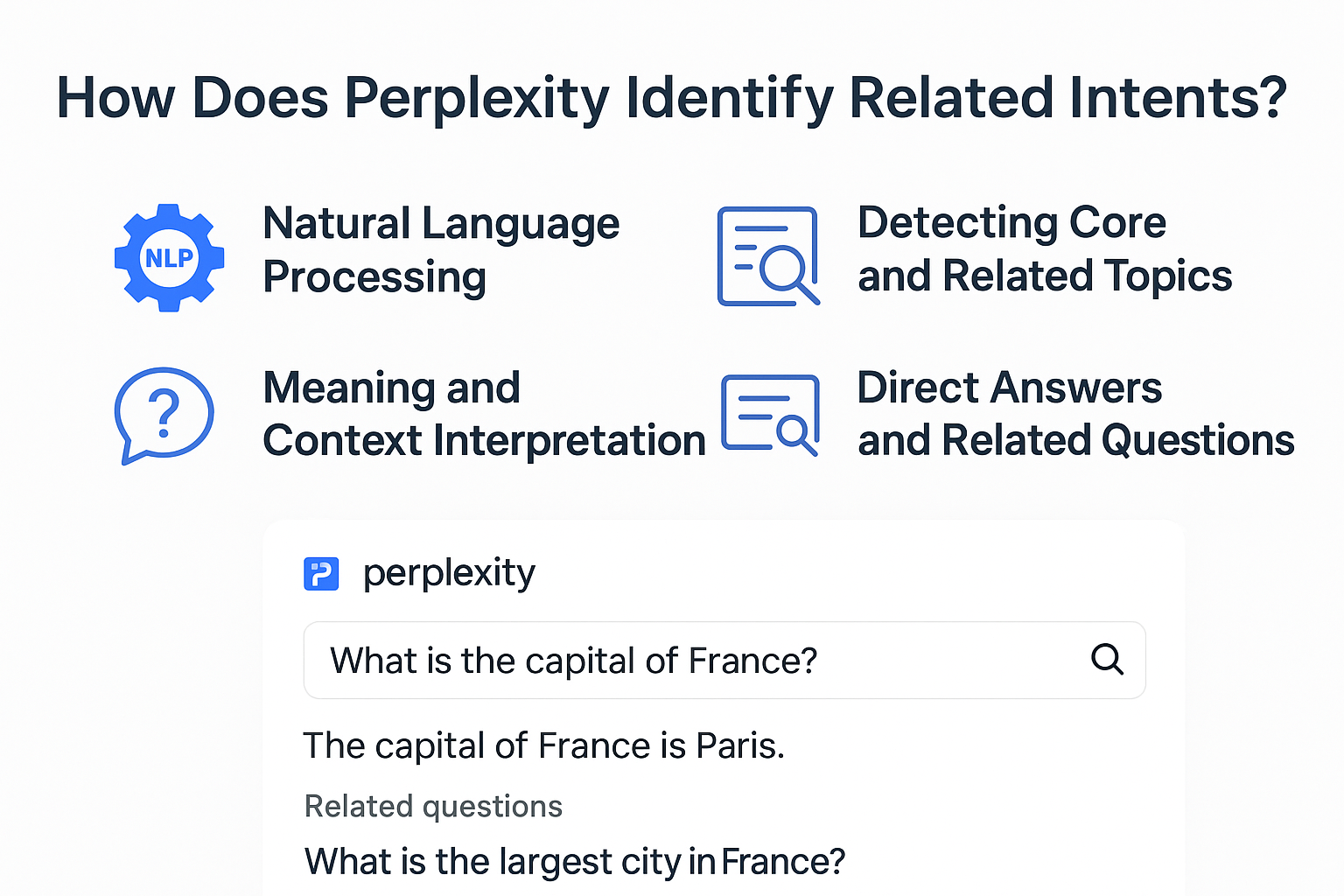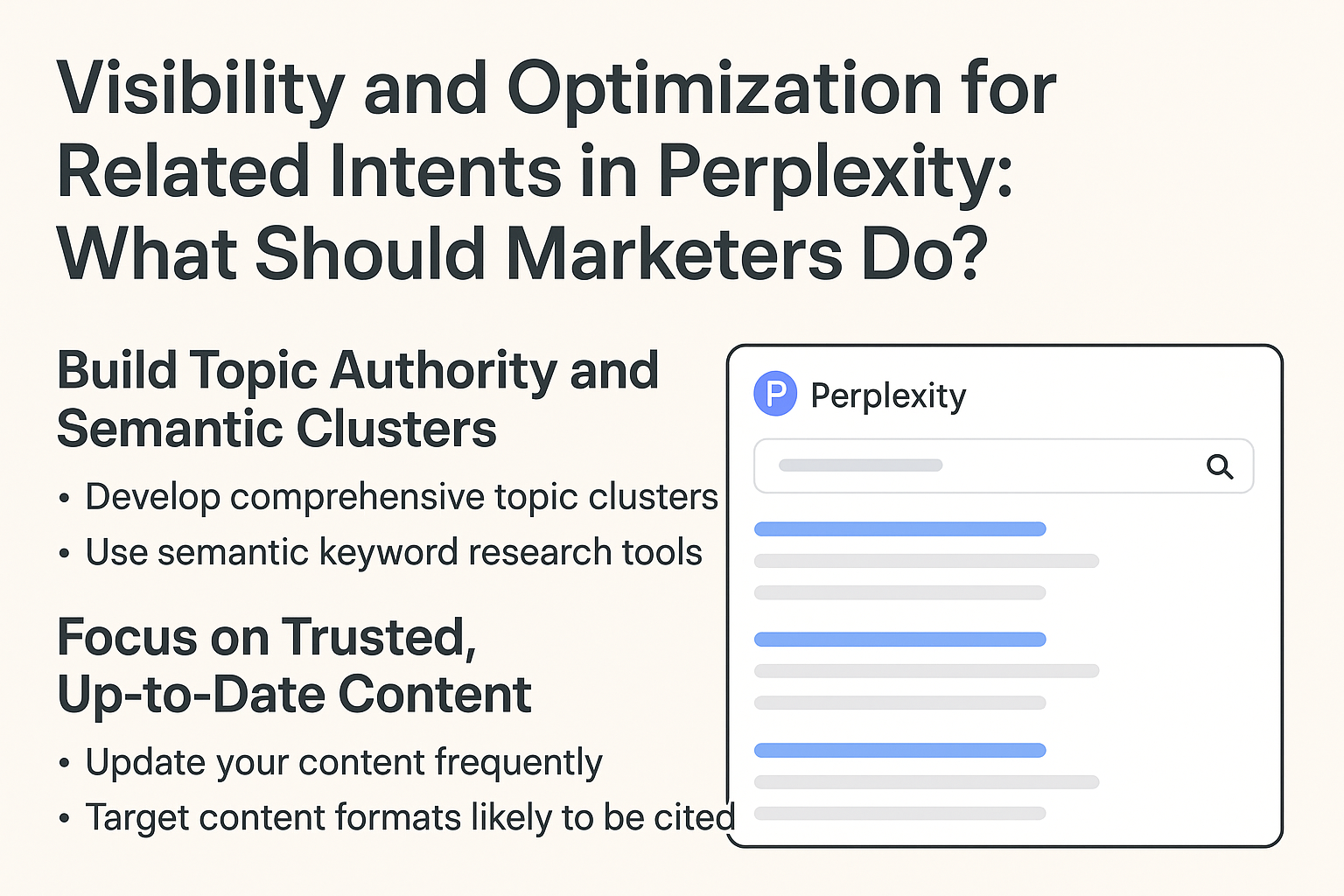How related intents are identified in perplexity?

Summary (TL;DR)
Perplexity identifies related intents by leveraging advanced natural language processing (NLP), semantic search, and real-time web data. It dissects user queries into key topics and sub-questions, maps intent to related concepts using AI language models, and cross-references trusted sources live for contextual alignment. For marketers and SEO consultants, optimizing for related intents in Perplexity means focusing on topic clusters, semantically connected keywords, and authoritative citations to maximize visibility and share of voice.
---
Introduction
AI-powered answer engines such as Perplexity are transforming how search intent is understood and addressed. Unlike traditional search engines that rely largely on keyword matching, Perplexity leverages cutting-edge language models and real-time data to go deeper—uncovering not just what users ask, but the underlying intent and all semantically related topics. This paradigm is crucial for marketing and SEO professionals tasked with optimizing digital visibility and authority. Understanding how related intents are identified within Perplexity is key to staying ahead of competitors in the rapidly evolving search landscape.
---

How Does Perplexity Identify Related Intents?
1. Natural Language Processing: Detecting Core and Related Topics
When a user submits a query, Perplexity applies NLP to extract key topics, sub-questions, and nuances of intent. Rather than simply parsing for keywords, the system interprets the meaning and context of each question, often breaking down complex or compound queries into their discrete elements. This enables the engine to surface not only direct answers but also content that addresses related questions and adjacent topics[[2]](https://www.appypieautomate.ai/blog/what-is-perplexity-ai)[[6]](https://www.getguru.com/reference/what-is-perplexity-ai-and-how-to-use-it).
- Example: A query like "How to optimize for featured snippets and increase organic traffic?" triggers Perplexity to analyze “featured snippets,” “optimization,” and “organic traffic” separately and together, understanding both the explicit question and its related search intents.
2. Semantic Search: Mapping Intents Beyond Keywords
Perplexity employs semantic search, enabling it to go beyond literal term matching to grasp conceptual relationships. Semantic algorithms recognize synonyms, contextually connected ideas, and hierarchical relationships (e.g., "digital marketing" > "SEO" > "on-page optimization") by leveraging large-scale language models trained to understand the structure and meaning of language[[7]](https://www.perplexity.ai/page/ai-semantic-search-explained-VkIQkD1FT6W6vC7zgxGNrA).
Comparison: Semantic Search vs. Keyword Search
| Aspect | Keyword Search | Semantic Search (Perplexity) |
|-----------------------|-----------------------------|-------------------------------|
| Matches | Literal keywords | Concepts, topics, synonyms |
| User Intent | Often missed | Deeply analyzed |
| Handling Variations | Weak (misses intent) | Strong (captures related) |
| Example Query | "SEO tools" | Finds "best software for search optimization" |
Actionable Insight: For SEO, this means your topic clusters and semantic keyword grouping are critical to capturing related intent in Perplexity’s results[[7]](https://www.perplexity.ai/page/ai-semantic-search-explained-VkIQkD1FT6W6vC7zgxGNrA).
3. Decomposition: Handling Multi-Intent and Layered Queries
Perplexity systematically decomposes multi-layered questions into subtasks, fetching data relevant to each intent, and then intelligently synthesizes a holistic answer. Each sub-intent—whether implied or explicit—is treated as a node in a search graph, increasing the coverage of related intents in the final response[[2]](https://www.appypieautomate.ai/blog/what-is-perplexity-ai).
- Example: A user asks, “Pros and cons of AI-powered SEO tools for e-commerce in 2025?” Perplexity breaks this into “benefits of AI SEO tools,” “drawbacks of AI SEO tools,” “applications in e-commerce,” and “latest (2025) trends.” Each sub-intent is addressed and connected in the answer.
4. Real-time Web Sourcing and Trust-Based Citation
Perplexity doesn’t operate solely on a static index. Instead, it performs live web searches, gathers information from up-to-date trusted sources, and references contextually relevant content in each result. This real-time sourcing allows Perplexity to surface emerging intents, trending subtopics, and recent industry changes as part of its answer set[[1]](https://www.m1-project.com/blog/what-is-perplexity-ai-and-how-it-works)[[3]](https://growbydata.com/solutions/llm-intelligence/perplexity-ai-monitoring/)[[6]](https://www.getguru.com/reference/what-is-perplexity-ai-and-how-to-use-it).
- For marketers: The sources you earn citations from matter. Authoritative, frequently updated, and context-rich pages are more likely to be included as references when Perplexity covers related intents.
5. Retaining and Linking Context Across Exchanges
Perplexity retains conversational context within a session, enabling it to identify and anticipate related follow-up intents. If a user explores a topic deeply through iterative queries, the system links these interactions to build a richer intent map and provide increasingly nuanced, relevant responses[[2]](https://www.appypieautomate.ai/blog/what-is-perplexity-ai).
Implementation Strategy: Create linked FAQ content, pillar-and-cluster articles, and guides that anticipate adjacent questions, ensuring each intent is fully covered and connected for both direct and related discovery.
---

Visibility and Optimization for Related Intents in Perplexity: What Should Marketers Do?
1. Build Topic Authority and Semantic Clusters
- Develop comprehensive topic clusters that interlink primary, secondary, and long-tail keywords within relevant content silos[[7]](https://www.perplexity.ai/page/ai-semantic-search-explained-VkIQkD1FT6W6vC7zgxGNrA).
- Cover related subtopics, FAQs, and adjacent user journeys within each piece.
- Use semantic keyword research tools to uncover related queries and intent overlaps[[6]](https://www.getguru.com/reference/what-is-perplexity-ai-and-how-to-use-it).
2. Focus on Trusted, Up-to-Date Content
- Update your content frequently to ensure it reflects recent trends and findings.
- Target content formats that are more likely to be cited by Perplexity, such as guides, research-backed articles, and detailed how-tos[[1]](https://www.m1-project.com/blog/what-is-perplexity-ai-and-how-it-works)[[3]](https://growbydata.com/solutions/llm-intelligence/perplexity-ai-monitoring/).
3. Optimize for Citations and Share of Voice
- Monitor which sources Perplexity cites for your main and related intents to identify gaps or opportunities to overtake competitors[[3]](https://growbydata.com/solutions/llm-intelligence/perplexity-ai-monitoring/).
- Build relationships and earn backlinks from authoritative sources that Perplexity’s engine recognizes as reliable.
4. Strategic FAQ and Conversational Content
- Create FAQ pages and conversational content that directly answer common and complex user questions as well as related intents.
- Anticipate follow-up queries that logically stem from the initial intent.
5. Leverage Real-Time Monitoring and Iteration
- Track how often your brand and competitors are cited in Perplexity’s answers, using this insight to finesse your content and PR posture[[3]](https://growbydata.com/solutions/llm-intelligence/perplexity-ai-monitoring/).
- Invest in tools that monitor AI-powered search engines’ recognition of your brand and optimize accordingly.
---
Conclusion/Key Takeaways
- Perplexity’s identification of related intents centers on semantic search, NLP-driven intent mapping, and real-time citation of trusted sources.
- Marketers and SEO consultants must adopt a topic cluster and pillar content strategy, with emphasis on semantic connectivity and up-to-date information.
- Monitoring share of voice in Perplexity’s live answers, as well as gaining citations from authoritative sources, directly boosts digital visibility for both primary and related queries.
- Success in the AI-driven search landscape now demands a holistic, intent-focused, and citation-optimized content plan.
---
FAQs
Q: How does Perplexity differ from Google in identifying related intents?
A: Perplexity uses deeper semantic analysis powered by language models and real-time web data rather than relying primarily on historical keyword and link data, allowing it to more accurately map and address related intents[[1]](https://www.m1-project.com/blog/what-is-perplexity-ai-and-how-it-works)[[7]](https://www.perplexity.ai/page/ai-semantic-search-explained-VkIQkD1FT6W6vC7zgxGNrA).
Q: How can I ensure my content is surfaced for related intents in Perplexity?
A: Prioritize comprehensive topic coverage, build semantic clusters, update content regularly, and earn citations from authoritative domains[[3]](https://growbydata.com/solutions/llm-intelligence/perplexity-ai-monitoring/)[[6]](https://www.getguru.com/reference/what-is-perplexity-ai-and-how-to-use-it)[[7]](https://www.perplexity.ai/page/ai-semantic-search-explained-VkIQkD1FT6W6vC7zgxGNrA).
Q: Are follow-up questions and session context important for intent mapping?
A: Yes, Perplexity tracks ongoing sessions, making FAQ sections and linked content critical for maximizing both initial and follow-up intent opportunities[[2]](https://www.appypieautomate.ai/blog/what-is-perplexity-ai).
Q: What types of sources does Perplexity trust the most?
A: It favors recent, high-authority, well-referenced sources—professional media outlets, established industry blogs, and research-powered pages[[1]](https://www.m1-project.com/blog/what-is-perplexity-ai-and-how-it-works)[[3]](https://growbydata.com/solutions/llm-intelligence/perplexity-ai-monitoring/).
Q: How frequently should I update my content for Perplexity optimization?
A: Regular updates are vital; in fast-moving verticals, monthly or quarterly reviews ensure ongoing inclusion in real-time AI search results[[1]](https://www.m1-project.com/blog/what-is-perplexity-ai-and-how-it-works).
---